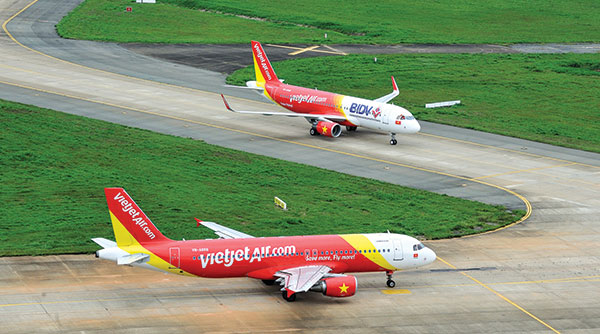Are low-cost carriers ready to take off?

Vietnam’s economy is experiencing a bad year, with a 13-year record low stagnant growth forecast of 5 per cent. Nevertheless, the Civil Aviation Administration of Vietnam (CAAV) estimates that the domestic aviation market is set to grow by 15-16 per cent in 2013, double last year’s figure of 7 per cent thanks to the robust growth of low-cost carriers (LCCs) in Vietnam. It seems that the expansion of low-cost carriers have significantly and positively reshaped the market.
An industry leap forward
According to a recent report produced by the International Air Transport Association (IATA), Vietnam is gathering pace to become the third fastest growing aviation market in the world behind China and Brazil.
The report estimates that by 2015, the aviation industry in Vietnam will be responsible for the transportation of 34-36 million of passengers and 850,000 to 930,000 tonnes of cargo.
These figures will respectively reach 52-59 million of passengers and 1.4-1.6 million tonnes of cargo by 2019. It also states the number of passengers on domestic routes will increase by 15-16 per cent in 2013, double 2012’s growth rate.
In light of this market boom, airlines in Vietnam are anticipated to undergo a two to three-fold increase in their fleet sizes to accommodate the travel demand of not only 90 million Vietnamese, but also the rapid increase in overseas visitors.
Vietnam Airlines is currently the market leader in Vietnam. The airline is in preparation for its initial public offering in the second quarter 2014. In addition, JetStar, a LCC in which Vietnam Airlines has a controlling interest, is planning to expand its fleet.
Last month, VietJetAir, the first privately-owned LCC in Vietnam, signed a $9.1 billion lease-purchase order with Airbus for 100 aircraft. Luu Duc Khanh, managing director of VietJetAir, said this number would continue to rise.
Experts suggested the main factor behind the immense potential for aviation in Vietnam was its 1,650km length, with major cities and tourist destinations spread throughout the nation.
As the national road and rail systems remain underdeveloped, air transport is currently offering the most efficient form of travel for the bulk of the country.
Additionally, Vietnam is within just a few hours flight of South Korea, Hong Kong, Thailand and China. This is an important factor in attracting overseas visitors to Vietnam. The country has received 5.5 million of tourists in the last nine months, a year-on-year increase of 10 per cent.
Increasing travel demand this year and a positive outlook for the coming years also signal growing commercial opportunities for aircraft manufacturers like Boeing and Airbus, whose involvement will help domestic airlines to attract further investment and thereby allow operators to expand their fleets and add more destinations to their networks.
Moreover, the growth of the aviation industry will act as the catalyst for economic, trade and tourism development.
LCCs are receiving stronger support from both the public and authorities. The government is investing heavily in building and upgrading airports, helping facilitate the development of private airlines, particularly LCCs. New airlines are exempt from corporate income tax for the first two years of profitable operations and enjoy a 50 per cent rebate for the following three years. Transport Minister Dinh La Thang claimed that “I expect VietJetAir to develop and compete successfully with Vietnam Airlines, so every one can fly.”
Dawning of a new era
Similar to the real estate market or the telecommunications industry, the aviation industry benefits greatly from the participation of different types of investors. Passengers benefit from diverse products and competition. Industry insiders echo this, believing the whole industry has undergone a huge transformation with the emergence of LCCs. The domestic market has become more open to competition, more flexible in pricing policies and more customer-oriented in terms of services and quality.
One of these LCCs, VietJetAir, despite its short history, has successfully established its presence in the Vietnamese aviation market. The airline is running nearly 500 flights per week on 14 domestic and two international routes to Thailand, with a fleet of 10 new Airbus aircraft. VietJetAir currently accounts for 25 per cent of the domestic market share and recently announced it had become profitable after just after two years of operations.
As a part of its business expansion strategy, VietJetAir frequently launches promotional campaigns to offer affordable and flexible fares to customers. For instance, to celebrate the introduction of the new Airbus A320 Sharklet with a Pepsi logo to its fleet, the airline has offered 100,000 tickets priced from just VND100,000 since the beginning of November.
Notwithstanding VietJetAir’s experiences, competition has had positive effects on supply and demand in general. Various promotional events are driving ticket prices to more affordable and accessible ground where millions of people can travel with more confidence than ever before.
Speaking of this phenomenon, an executive in the industry expressed his delight at seeing a passenger carrying plastic bags onto a VietJetAir flight. For him, it implied that air transport has become accessible and acceptable to the general public. To underline the increasing attractiveness of LCCs, former Singaporean Prime Minister Lee Kwan Yew once arrived in Vietnam for an APEC conference on a Tiger Airways flight, another LCC in the region.
Against the backdrop of a stagnant economy, the recent growth of the aviation industry and of LCCs in particular coupled with a promising forecast from IATA, offers reassuring news for the country.
What the stars mean:
★ Poor ★ ★ Promising ★★★ Good ★★★★ Very good ★★★★★ Exceptional
Latest News
More News
- Power of partnerships: 30 years of Bayer in Vietnam (November 22, 2024 | 15:34)
- Consumption demand driving export performance (November 22, 2024 | 10:59)
- Rice exports set to break records (November 21, 2024 | 17:53)
- Growth beckons for GenAI startups in Vietnam (November 21, 2024 | 17:47)
- SABECO to elevate Vietnam's beverage industry to global standards (November 21, 2024 | 17:36)
- ABeam Consulting Vietnam introduces BSQCD Purchasing Strategy Framework (November 21, 2024 | 16:40)
- Major railway requires debt considerations (November 21, 2024 | 12:07)
- Reviving a new life cycle for plastic waste (November 21, 2024 | 09:16)
- Key balances maintained for industrial production (November 21, 2024 | 08:00)
- Ecolean Vietnam honoured with prestigious sustainability award (November 19, 2024 | 10:01)

















 Mobile Version
Mobile Version